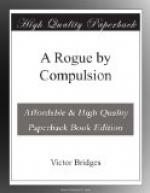It is thought that he has made his way over North Hessary and is lying up in the Walkham Woods. In any case it is practically certain that he will not be at liberty much longer. It is impossible for him to get food except by stealing it from a cottage or farm, and directly he shows himself he is bound to be recaptured.
Considerable excitement prevails in the district, where all the inhabitants are keenly on the alert.
The marks murder
echoes of A famous case
The escape of Neil Lyndon recalls one of the most famous crimes of modern days.
On the third of October four years ago, as most of our readers will remember, a gentleman named Mr. Seton Marks was found brutally murdered in his luxurious flat on the Chelsea Embankment. It was thought at first that the crime was the work of burglars, for Mr. Marks’s rooms contained many art treasures of considerable value. A further examination, however, revealed the fact that nothing had been tampered with, and the next day the whole country was startled and amazed to learn that Neil Lyndon had been arrested on suspicion.
At the trial it was proved beyond question that the accused was the last person in the company of the murdered man. He had gone round to Mr. Marks’s flat at four o’clock in the afternoon, and had apparently been admitted by the owner. Two hours later Mr. Marks’s servant returning to the flat was horrified to find his master’s dead body lying in the sitting-room. Death had been inflicted by means of a heavy blow on the back of the head, but the state of the dead man’s face showed that he had been brutally mishandled before being killed.
The accused, while maintaining his innocence of the murder, did not deny either his visit to the flat, or the fact that he had inflicted the other injuries on the deceased. He declined to state the cause of their quarrel, but the defending counsel produced a witness in the person of Miss Joyce Aylmer, a young girl of sixteen, who was able to throw some light on the matter.
Miss Aylmer, a young lady of considerable beauty, stated that for about a year she had been working as an art student in Chelsea, and used occasionally to sit to artists for the head. On the afternoon before the murder she had had a professional engagement of this kind with Mr. Marks. There had been a visitor in the flat when she arrived, but he had left as soon as she came in. Subsequently, according to her statement, the deceased had acted towards her in an outrageous and disgraceful manner. She had escaped from his flat with difficulty, and had subsequently informed Mr. Lyndon of what had taken place.
In his re-examination, the accused admitted that it was on account of Miss Aylmer’s statement he had visited the flat. Up till then, he declared, he had had no quarrel with the deceased.
This statement, however, was directly contradicted by Lyndon’s partner, Mr. George Marwood. Giving his evidence with extreme reluctance, Mr. Marwood stated that for some time bad blood had undoubtedly existed between Mr. Marks and the accused. He added that in his own hearing on two separate occasions the latter had threatened to kill the deceased.




